The BeachLife Festival reimagines Redondo

Willie Nelson & Family play BeachLife Festival in Redondo Beach Sunday evening. Photo by JP Cordero (CivicCouch.com)
Ten thousand people came to the beach last weekend in Redondo Beach, all because a teenage boy lit a fire 28 years ago.
Allen Sanford was a thoughtful juvenile delinquent. He didn’t want to do harm. He just wanted people to stop and wonder for a second. So as a 13-year-old kid, he snuck out late one night and lit a little fire in the middle of a street near his home. It was two in the morning, and back then that meant quite a few wobbly drivers were on the road after a night’s carousing.
“I’d just light tiny little fires in the middle of the street…. People would be driving home from the bars and kind of trip out, get out of the car and kind of look,” Sanford said. “It was kind of surreal.”
He got caught. His dad didn’t see the surrealistic humor in it. Sanford ended up grounded at his house for the next year. His father Joe Sanford, after his initial anger subsided, ended up feeling sorry for the boy. He bought his son a Gibson Les Paul electric guitar. For the next six months, Allen sat in his room with the guitar and a cassette player loaded with Led Zeppelin IV. He taught himself every song, and he was never the same again. Music became his fire.
“I ended up grounded only six months but I spent the whole time in my room hitting rewind and fast forward on that cassette hours and hours every day,” Sanford said. “It just grew on me. I just loved playing. Music became a part of my life. Now I can’t imagine a life without music.”
Last weekend, Sanford lit a fire of another sort. It was just as rock ’n’ roll at its core, but it was a very big fire. It was a congregation and a celebration. Sanford launched the BeachLife Festival, the biggest and best musical congregation in the history of the South Bay. The festival included more than 40 bands and was headlined by Willie Nelson, Bob Weir, and a truly historical reunion — the return of Beach Boys Brian Wilson and Al Jardine to the beach that inspired their musical beginnings six decades ago.
Wilson, a famously reticent artist who has bravely weathered an array of health issues for decades, took his place behind a large white piano Saturday night in an unusually ebullient mood.
“It’s good to be back home again,” he said, before the band launched into a set jam-packed with a lot of the music that helped define beach life — including “Surfing U.S.A.” with it’s Redondo Beach–specific lyric (“Tell the teacher we’re surfin’/Surfin’ U.S.A./Haggerties and Swamies/Pacific Palisades/San Onofre and Sunset/Redondo Beach, L.A….”) and a particularly poignant rendition of “Do It Again.” Wilson, who receives help from Al Jardine’s son Matt on the high notes for most songs, took “Do It Again” himself. It was clear that the song meant something special to the 76-year-old musical genius:
“It’s automatic when I
Talk with old friends
The conversation turns to
Girls we knew when their
Hair was soft and long and the
Beach was the place to go
With suntanned bodies and
Rays of sunshine the
California girls and a
Beautiful coastline….
Well I’ve been thinking ’bout
All the places we’ve surfed and danced and
All the faces we’ve missed
So let’s get back together
and do it again…”

Brian Wilson and Al Jardine. Photo
In the front of the stage, dancing with his mother, was the man who brought BeachLife to musical fruition. Adam Spriggs was the festival’s talent buyer, but this was something more than a moment of professional pride. The Beach Boys were the first band he ever saw in concert.
“October 25, 1987. Louisville Gardens, Louisville, Kentucky,” Spriggs recalled. “I was 9. My mom took me. And then we took my grandparents every summer thereafter to see them. It was the one band we all agreed on.”
BeachLife was an almost perfectly executed festival. Six thousand people came on Friday, and nearly 10,000 both Saturday and Sunday. Yet somehow, there was no dehumanizing sense of a cattle call, no big lines — not cars, not people waiting for restrooms, not even in the beer tent. The festival gave everyone space to breathe, and breathed life into a place, King Harbor, that many had long left for dead, a soon-to-be-demolished relic of a better past. And perhaps most significantly, the musical curation was stunningly on point. There were the big moments — 10,000 people singing “Mamas Don’t Let Your Babies Grow Up to Be Cowboys” along with Willie Nelson as he closed out the festival Sunday night at the main “High Tide” stage, not long after maybe 4,000 people danced in the sand and sang along with Ziggy Marley’s joyous version of his father’s song, “Coming in from the Cold” in the brilliantly re-purposed Seaside Lagoon, aka the “Low Tide” stage. And there were smaller, but no less beautiful moments — the legendary Poncho Sanchez leading a rousing version of “Besame Mama” on the Rip Tide stage, a couple hundred yards from where he started his career five decades ago, playing Concerts by the Sea with his idol, the jazz great Cal Tjader (the venue that later become Brixton, which Spriggs and his wife Carrie ran 15 years ago, first bringing Sanchez back to the beach).
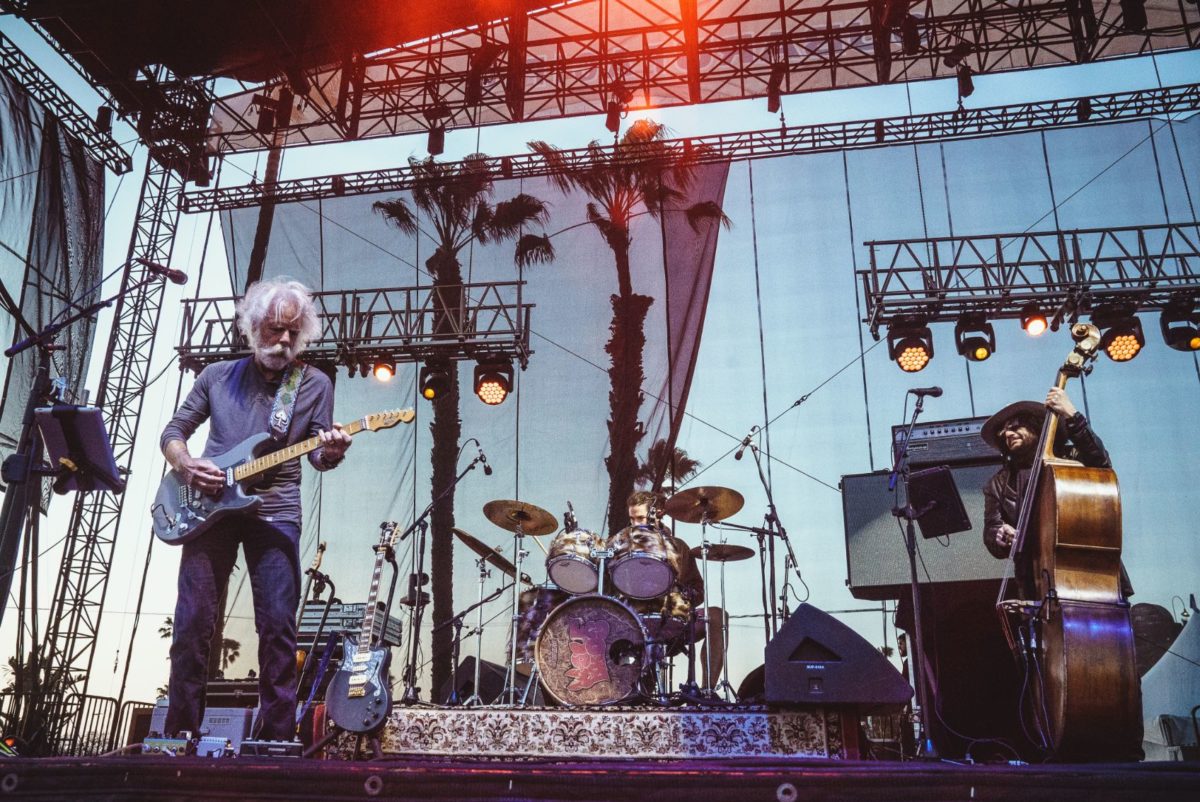
Bob Weir and the Wolf Bros headlining BeachLife. Photo
Then there was the hauntingly beautiful appearance of a true tribal elder of the whole festival scene, Bob Weir (with his band Wolf Bros), who closed out Friday night with the Black Crowes’ Chris Robinson (whose band As the Crow Flies made their only appearance of the year at BeachLife earlier in the evening) joining for a rip-roaring version of “Not Fade Away” and then devastating everyone left standing with an elegiac rendition of “Ripple,” a song from his days with his former band, the Grateful Dead:
“If my words did glow with the gold of sunshine
And my tunes were played on the harp unstrung
Would you hear my voice come through the music
Would you hold it near as it were your own?”
Somewhere in that lyric is the secret to what transpires when people commune with music: we all gather around the fire, and all voices become one. Weir, the Grateful Dead’s brown-eyed handsome man, has worn gracefully into a grizzled 71-year-old. And while many of his compatriots are long gone — including bandleader and musical revolutionary Jerry Garcia — Weir has faithfully kept the fire lit and the songs raised high. At one point he sang “Me and Bobby McGee,” and you couldn’t help but think of the epic 1970 train ride the Dead took with Janis Joplin documented in the documentary “Festival Express,” in which a young Weir accompanied Joplin on the same song.
Something about the night must have enchanted Weir. His set was scheduled to end at 9:15 p.m., which was the festival’s curfew time. But Weir wanted to do more. Sanford had brought Redondo Beach Mayor Bill Brand backstage; Brand had come to the festival with a ticket from a 1978 Bob Weir show (which Weir obligingly signed). He nodded: the show could go on.
“Do you want to do ‘Ripple’?’” Spriggs asked tentatively. “That’s a short one.”
Weir turned to the Wolf Bros. “Ripple,” he said.
“And he takes off and does ‘Ripple’,” Spriggs recalled. “Epic.”
The singer sang alone center stage, his voice as worn and warm as his whiskery face.
“It’s a hand-me-down, the thoughts are broken,” Weir sang. “Perhaps they’re better left unsung. I don’t know, don’t really care. Let there be songs to fill the air….”
Festival dreams
Why do we fest?
Many of the 10,000 people who arrived in the Redondo Beach harbor Saturday paid hundreds of dollars to be there. Quite a few paid thousands, not just for the various VIP festival access levels that BeachLife offered, but in traveling and lodging costs. Although BeachLife Festival marketing focused almost entirely on the South Bay, people came from 38 states and 19 countries. They came because of the names on the top of the festival poster, certainly, and they came because of the literal lure of California beach life. But more than anything, in spite of the costs and wearing challenges of their workaday lives, they came to be together with other like-minded souls and to celebrate. They came to fest.
Saturday afternoon, Dawes performed on the Low Tide stage. The band is more well known on the festival circuit and for backing Jackson Browne a few years ago than they are from any radio airplay or larger pop culture success. Dawes is built around Malibu-born brothers Taylor and Griffin Goldsmith, the lead singer, and drummer, respectively, and while they are classified genre-wise as an Americana act, their influences emanate from the heyday of the California singer-songwriter scene — the likes of Browne, Warren Zevon, and Neil Young.

Taylor Goldsmith of Dawes. Photo
Somehow in the course of Dawes’ 80-minute set, some kind of communion happened. It wasn’t a sweaty kind of rock ’n’ roll revival gathering that sometimes happens when the twang of loud guitars fills the air, or even a moment of any part nostalgia that comes when someone sings a song whose lyrics you know by heart. It was a man telling stories and a few thousand people swaying and really listening.
Somewhere in the heart of his song, “A Little Bit of Everything,” Taylor Goldsmith might have answered part of the question of why we fest.
It’s a little bit of everything, it’s the matador and the bull,
It’s the suggested daily dosage, it is the red moon when it’s full.
All these psychics and these doctors, they’re all right and they’re all wrong,
It’s like trying to make out every word, when they should simply hum along,
It’s not some message written in the dark, or some truth that no one’s seen,
It’s a little bit of everything.
We fest, in other words, for a little bit of everything. After the song, Goldsmith looked out into the audience. “I want to say it’s days like these that we live for, where we get to come up here and talk about some pretty personal shit, and have you guys out there as more or less a bunch of strangers and we are able to connect because these emotions and experiences that we otherwise don’t feel comfortable talking about very often,” he said. “I feel that is as good as a day can get. I feel connected with you, I feel open with you. I don’t normally talk like this. So I just want to say thank you for letting this happen, for taking it to this point.”
Taking it to that point, where a band would ever be performing and thousands congregating in Seaside Lagoon, was an unlikely occurrence to begin with, and certainly took a little bit of everything. The festival grounds have been in the political crosshairs in Redondo Beach for fully two decades, as several redevelopment plans have come and gone.
Brand, the mayor, has been at the center of the fight against each development. It is, in fact, what brought him into local politics. When he arrived at the festival Friday afternoon, he experienced a “show, don’t tell” moment — the thousands of hours of political talk he’d waded into over the last 18 years could not have better conveyed the point he’d been trying to make all along as well as a single song sung at Seaside Lagoon.
“I’ll tell you, it’s a lot more fun than 3,000 condos and a 525,000 square foot mall,” Brand said. “This is more what Redondo is about than anything I’ve seen before in the city since I’ve been paying attention… This is about the community. We left a left a lot of money on the table as a city, but it’s not what the community really wanted. The residents left a lot of money on the table — in their interest of their own quality of life.”
“We could be standing in a food court,” Brand said, referencing the most recent development plan, a retail and restaurant lifestyle center proposed by CenterCal. “Instead, we are waiting for Bob Weir to come on. It makes this feel like a huge victory.”
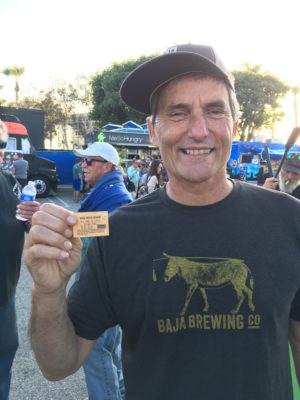
Redondo Beach Mayor Bill Brand with a Bob Weir concert ticket from 1978. Photo
BeachLife began for Brand a little bit more than a year ago, right after he was elected mayor (after serving two terms as a councilman) and a ballot initiative called Measure C passed that restricted future development in the harbor area.
“Allen Sanford came to me right and basically said, ‘We want to show you what we need to be doing with your waterfront.’ And he laid the whole thing out, and I said, ‘Allen, you go,’” Brand said. “There were a lot of machinations, but he made it happen.”
The idea for the festival had been coalescing in Sanford’s mind for 20 years. He attended Santa Clara University, as a philosophy major, but music was always his passion. He played guitar in a band called Overhead during his college years, but quickly realized performance wasn’t his art. “It should have been called, ‘Over My Head,’” he said.
Instead, he went to work at Patrick Malloys on the Hermosa Beach pier. He started busing tables but soon asked owner Fred Hahn to let him manage the place. Hahn said no, but Sanford made a counterproposal: he’d do it free for three months to prove himself. Okay, kid, Hahn said, and Sanford was off and running.
“It was rad,” he said. “I have the keys to the bar and I’m 21 years old. I had never managed anything, never worked in a bar, nothing, then I start managing a bar, then start booking bands Wednesday nights. So I booked Eek-a-Mouse, Common Sense, and this little band out of San Diego nobody knew, Slightly Stoopid. They were $50 and a case of Red Bull.”
He went on in the next few years, with an investment group that included his brother Jed, to open up the Union Cattle Company up the street in Hermosa. By the time he was 30, he opened up his own music venue, Saint Rocke, on PCH, also in Hermosa. For a 280-seat venue, the club quickly became known for the ambition of its bookings — over the years, bands that never play clubs, such as Bush, Pennywise, Amos Lee, and Nofx would play there.
Along the way Adam Spriggs came to Sanford’s attention, but not in a good way. Spriggs was booking and running a bigger club underneath the Redondo Beach pier, Brixton, and he was really good at it. Brixton brought in a wide array of acts, both popular ones and those with deep street cred — Leon Russell, Skid Row, and Toad the Wet Sprocket — and some genuine legends sat in for sets on its stage, including Prince and Stevie Wonder.
Sanford was convinced the town wasn’t big enough for two music clubs less than a mile from each other; the South Bay over the last decades has not been known as a place that strongly supports live music (with the notable exception of Cafe Boogaloo, a blues bar that succeeded largely through the force of will of its owner Steve Roberts). Saint Rocke and Brixton engaged in a bidding war over bands for two years; Brixton lost, and went out of business.
Right after, Spriggs got a call from Sanford.
“Let’s join forces,” Sanford said.
Spriggs was a little shocked. Sanford had been his enemy and the closing of Brixton made staying in the South Bay look increasingly impossible for him.
“I love the South Bay, it was our home, so the thought of being able to keep with a club down here, even if it was a former hated rival, interested me,” he said.
Spriggs is known within the music industry as something of a savant. His knowledge of bands is encyclopedic, and the degree to which he supports the ones he loves is unusual in what is often a cutthroat industry.
“Adam is a special guy,” Sanford said. “He loves music as much as anybody in the world. Even though he’s very much a grown up, married and with a kid, he is really just a small boy from Kentucky who loves these artists.”
Spriggs’ “aha!” moment came at age 11 when he saw a Bon Jovi/Skid Row concert.
“Like, this is much more than these tapes I am listening to at home,” he recalled. “I can’t believe this really exists. You mean, I can sing along at the top of my lungs and the band is still louder than me?…Twenty thousand people are having this moment.”
He had a realization that would never leave him: “This is what life is about. I just want this.”
To the beach
Sanford took over producing the Hermosa Beach Summer Concerts 11 years ago. Spriggs joined him in 2013. Together they turned it into a signature event in the South Bay, beautiful Sunday evenings with families laying out blankets on the beach and kids running around and everyone swaying to bands such as Robby Krieger of the Doors, Everclear, Brett Dennen, and the Pine Mountain Logs.
But Sanford was thinking bigger. He had a small taste of what he wanted when he was able to bring in Jimmy Buffet for “Fin Fest” in 2014. But he had this vision he couldn’t get out of his head: Willie Nelson at the beach, headlining a festival.
“The Hermosa Summer Concerts were really the birthplace of the idea,” Sanford said. “Hermosa is where I wanted to do it, but we never could. There just wasn’t the leadership in place to do it there.”

Adam and Carrie Spriggs.
Spriggs, who works for a well-regarded national talent buying agency, Madison Entertainment, booked the first few years of KAABOO, a major festival that started in Del Mar and has now expanded to Texas. His reach as a talent buyer expanded, and over the next four years working on KAABOO, he learned a lot about building a festival.
About a year ago, right as his relationship with Hermosa Beach city leaders began to deteriorate, Sanford — who with another business partner, Rob Lissner, runs a live streaming concert site and app called LiveList — happened to take part in a livestream of Robert Plant (from his original musical love, Led Zeppelin) performing at A Festival.
“And I heard him sing, ‘Going to California,” Sanford said. “That cemented it. I had to do BeachLife. Full circle.”
The City of Redondo was waiting for him with open arms. And Spriggs was truly ready to rock ’n’ roll. His marching orders were first and foremost: get Willie Nelson. It was the picture Sanford had in his head, and he also happened to be his father’s favorite performer. Spriggs quickly discovered something else: if he could get Willie, other artists would line up.
Spriggs, Lissner, Sanford, and marketing director Katie Henley, whom Sanford first hired a decade ago when she marched into his office and declared she was working for him, and whom he lured back from New Orleans with BeachLife, began brainstorming: what should a festival at the beach look like?
Everyone agreed they had to get Brian Wilson. Bob Weir was a less obvious choice, but it somehow just made sense. Others were counterintuitive. Spriggs remembers taking his son Hudson out on the beach one day about halfway through the process and hearing, in sequence, on the radio, a Men at Work song, then the Beach Boys, then Berlin. He’d already booked all three.
“We must be doing something right,” he recalled thinking.
The final lineup made more sense than anyone could have imagined. Strange strokes of good luck happened throughout. As the Crow Flies wasn’t even touring this year, but Spriggs made them an offer, anyway. Even he was shocked when they accepted. The Foo Fighters’ Taylor Hawkins, with his band Chevy Metal, agreed to do a set of Van Halen. Slightly Stoopid, Sanford’s long ago buddies, who have gone on to huge success, not only agreed to play but do something they’ve only done once in the last decade — a fully acoustic set (which Bob Weir ended up sitting in on). Jason Mraz agreed to make BeachLife his one Southern California stop on his current tour. In short, a masterpiece of booking, and festing, came together.
(Jim Lindberg, Pennywise’s lead singer, was brought in as creative director. Many people thought this meant he’d booked it, which was not the case. His job was “basically giving the thumbs up,” he told Pollstar this week).

Chris Robinson of As the Crow Flies at BeachLife. Photo
On Sunday afternoon, Janet Barker, a longtime Redondo resident, former Daily Breeze reporter, and much beloved creative writing teacher at Parras Middle School, was wandering around Seaside Lagoon after Ziggy Marley’s set with a wide and exhausted smile on her face. She’d just experienced her very first festival, and it happened to be in her hometown. She’d loved everything about it, from Jason Mraz’s groovy set and ecological message on Saturday to the return of Brian Wilson, whom she spent two days with as a reporter a decade ago and came to know as an unbelievably sweet and tender soul.
But the festival had done more than entertain Barker. It’d lifted the roof off the top of her head.
“This opens up a whole new world of possibilities,” she said. “I think for anybody in the community, in the South Bay but Redondo Beach in particular, we can now envision the possibilities for this oceanside community. It opens it up completely. Just wow: look at all these people… It’s just a whole celebration of where we live.”
“What I really love is the ongoing possibility. The canvas is open.”
Sanford said the head of LiveNation, who was at the festival, expressed astonishment that such a place as the Redondo harbor existed and had not previously been discovered as an entertainment venue. Sanford also received the same request from roughly 100 different people over the weekend: can you just leave the stages up? The answer was no, of course, but the philosophy major in him understood the question.
“I am interested in things that connect people, and so far as I can see there are three things everybody on this earth does… one is eating, one is to reproduce, and one is music,” he said. “I don’t care who you are or what culture you are in, whether in New Zealand, Africa, or the U.S., every culture has it’s music, a collection of sounds formed in different ways that entrances human beings. All of a sudden, people in their everyday lives who can’t agree on anything can come together and move and shake to those sounds.”
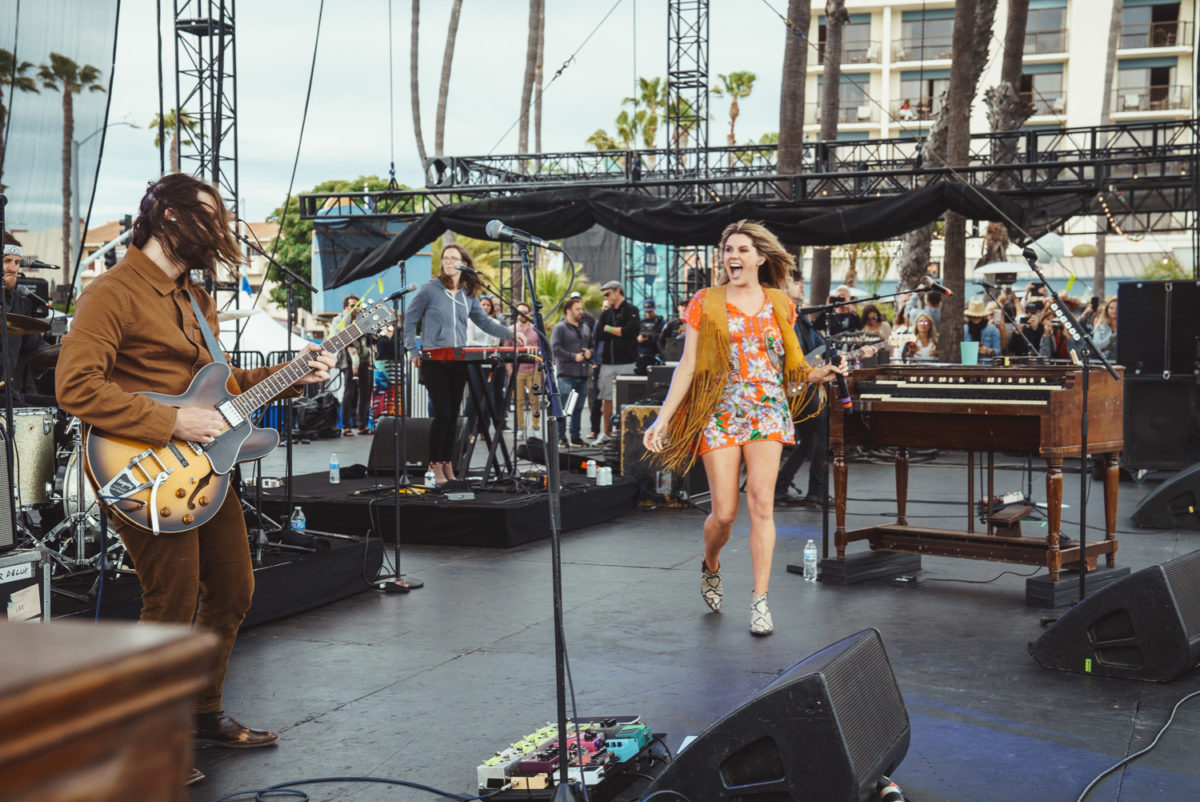
Grace Potter performing at BeachLife Festival. Photo
Everybody and everything at BeachLife just somehow seemed to come together. For Sanford and Spriggs, it was a culmination both personally and professionally.
Spriggs had several moments that he’ll remember til his dying day. One in particular involved his mother, Donna Hall, who took him to his first concerts. She loves Grace Potter, the brilliant Flying-V playing rock goddess from Vermont who played Sunday afternoon. Donna met Grace backstage and had a warm private chat, in which she requested a song, “Stars.” The song wasn’t on the setlist, but Potter not only played it, but introduced the song by dedicating it to Sprigg’s mom.
“I had a very nice request for this song today from a lovely lady named Donna, whose son put on this festival,” Potter said. “I think I now know what it means to be a proud mama, and this is a very cool festival, and she has a lot to be proud of, as do we all for being able to be here today.”
As the festival wound down, Sanford was thinking of something his father, Joe, had told him a long time ago, something that was more resonant now than ever. “My Dad always said, ‘Don’t ever discount what happens, because it’s all a stepping stone, walking down the path — every step is building to the next step,” he recalled. “You might take a left, or a right, but it’s all learning. Looking back, in hindsight it all totally makes sense.”
Sunday night, before Willie Nelson took the stage, Sanford was able to introduce him to his own hero, his dad, who’d first put that guitar in his hand and indirectly got the ball rolling that culminated in BeachLife.
“That really choked me up,” Sanford said. “So many full circles.”
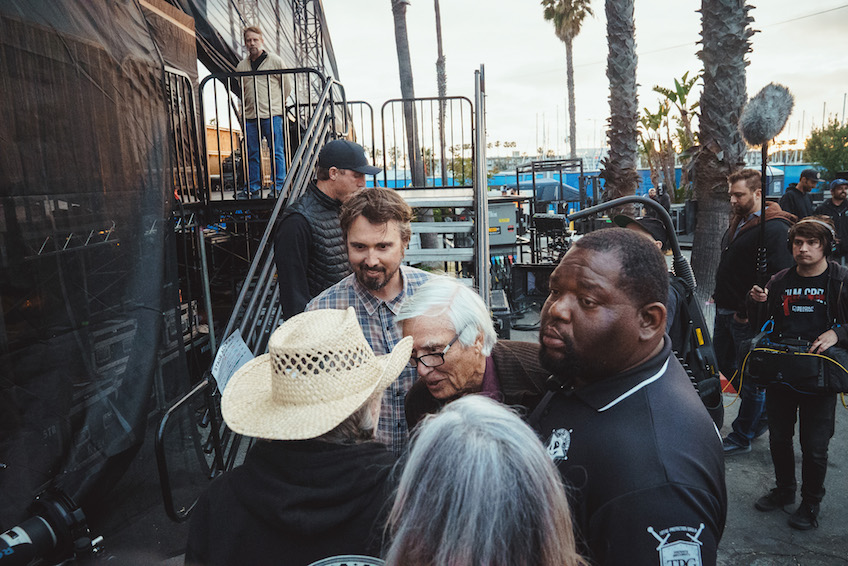
Joe Sanford, with his son Allen, meets Willie Nelson. Photo
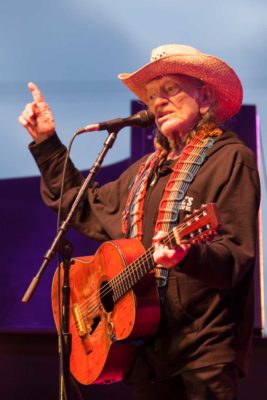
Willie Nelson at BeachLife. Photo by J.P. Cordero
Another family’s father, Ray Seager, was sitting on the side of the stage with his wife Susan. Seager will turn 80 in July. Earlier in the year he had told his daughter Marianne Carruth he wanted to throw a big birthday party. “I want at least 100 people, a taco truck, and Willie Nelson to play at my party,” Seager said at the time.
Then came the bad news: Seager’s cancer, which he’d been seemingly successfully fighting, had come back. The request to see Willie became more urgent. His daughter emailed BeachLife organizers. One of them, Denise Irwin, got back to her. She put Ray and Susan on the side of the stage.
“There they were, up there on the stage, oh my gosh,” Carruth said. “Besides Willie, I think they were the oldest couple there, you know? And they stood put that way. They were a little slower and wobbly and mom with her red outfit and dad with his hat — they definitely stood out. They were kind of famous.”
Willie, who turned 86 a couple weeks ago, doesn’t usually stay on stage the entire set. He lets members of his family band take lead duties here and there to conserve his energy. But on Sunday night, something about the congregation apparently gave him just a little bit more energy. He stayed on stage and sang every song, and those who were close up saw something unusual. During “Always on My Mind,” a tear rolled down Willie’s cheek.
“Tell me,” he sang, “tell me that your sweet love hasn’t died. And give me, give me one more chance to keep you satisfied. I’ll keep you satisfied.”

